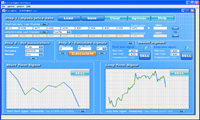Price-oscillator divergences in the forex market are instances when there is a technical imbalance between the price movement on a currency pair and an oscillator’s movement. Divergences should not be considered complete, self-contained trading strategies. Rather, they should be regarded as signals that warn of some potential impending directional bias. As such, divergences are not standalone indicators - they should confirm or be confirmed by other technical indications.
The oscillator that is used to identify divergences can be any of a number of different chart studies that can be found on any forex charting platform. These include: Stochastics, Relative Strength Index (RSI), Moving Average Convergence/Divergence (MACD), MACD Histogram, Rate of Change (ROC), Momentum, Commodity Channel Index (CCI), Williams %R, or any other oscillator that travels between defined horizontal bounds.
Once an oscillator is chosen, the process of searching for divergences is straightforward. There are two types of divergence that every technical forex trader should be aware of: regular divergence and hidden divergence.
Regular divergence is the most popular type, and it is what most traders mean when they refer to the general concept of divergence. Regular divergence serves as an early potential signal that a loss of momentum and a potential price reversal may be in the making.
The signal is manifested in an uptrend when price makes a higher high while the oscillator makes a lower high. This is called bearish regular divergence, and warns of a potential reversal and possible subsequent move to the downside. The opposite is called bullish regular divergence and occurs during downtrends. In a bullish divergence, price makes a lower low while the oscillator makes a higher low. In both cases, bearish and bullish, the oscillator diverges from price, giving an indication that price momentum in the currently prevailing direction may be waning.
If either type of regular divergence is identified on a currency chart, forex traders should immediately seek confirmation of a potential reversal before taking any trading action. This confirmation can take many forms, and usually involves other technical indications like a trendline or moving average break, a reversal candle pattern, or some other chart reversal pattern.
In contrast to regular divergence, the second type of divergence, called hidden divergence, can be considered the polar opposite. This signal is also a technical imbalance between price movement and oscillator movement. But instead of signaling a potential reversal, hidden divergence is used primarily to signal a potential continuation in the prevailing trend. As with regular divergence, there are also two basic manifestations of hidden divergence.
Bearish hidden divergence usually occurs during a downtrend, and is characterized by price making a lower high while the oscillator makes a higher high. In this case, price and the oscillator are diverging in their signals, but the overriding signal that should be taken from an occurrence of bearish hidden divergence is a potential continuation of the lower highs in price, which is the equivalent of a potential continuation in the prevailing downtrend. Bullish hidden divergence usually occurs during an uptrend, and is characterized by price making a higher low while the oscillator makes a lower low. In this case, price and the oscillator are diverging in their signals, but the overriding signal that should be taken from an occurrence of bullish hidden divergence is a potential continuation of the higher lows in price, which is the equivalent of a potential continuation in the prevailing uptrend.
As with regular divergence, confirmation should also be sought for instances of hidden divergence before any trades are actually placed. This confirmation can also take many forms, and usually involves other technical indications.
Divergences are common and useful signals that are best utilized as warnings, or confirmations, of potential reversals (regular divergence) or potential trend continuations (hidden divergence).
- James Chen, CTA, CMT
* I will be key speaker at FXstreet.com’s International Traders Conference in Barcelona, Spain in October 2009 - for more information, please go to: www.traders-conference.com .
* For information on my book, Essentials of Foreign Exchange Trading (Wiley), please click here.
* Follow my intraday forex updates on Twitter: http://twitter.com/JamesChenFX




